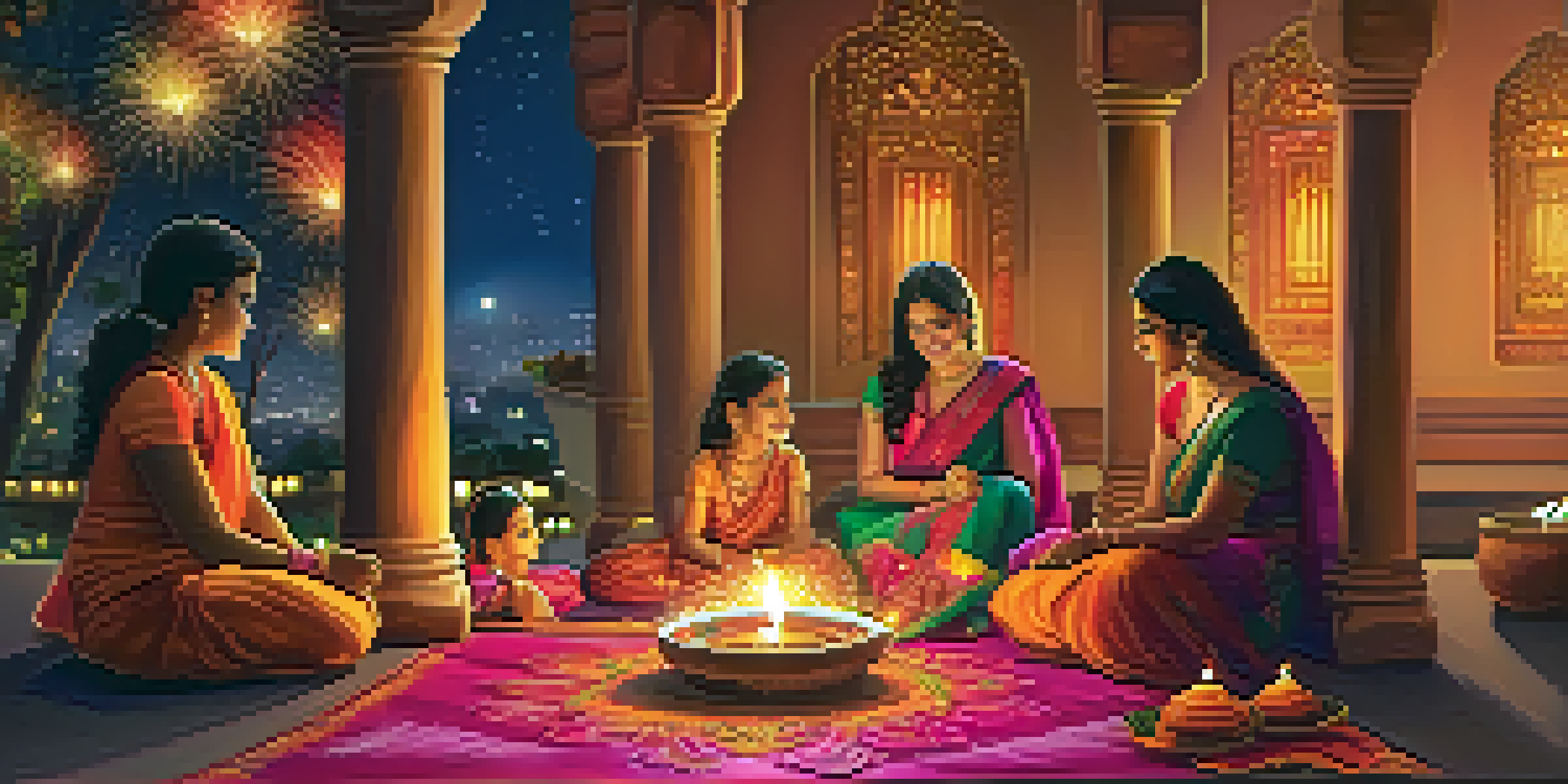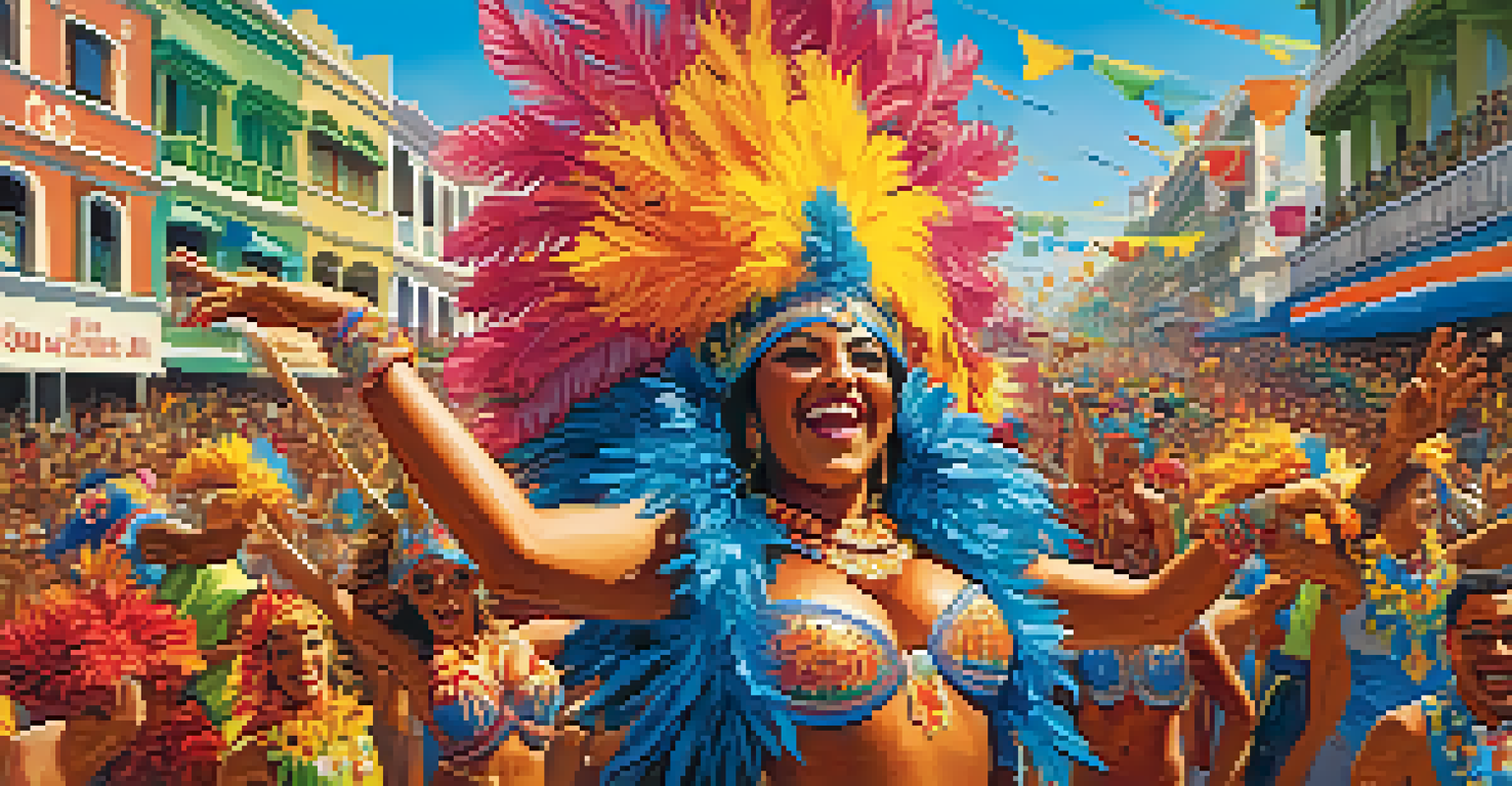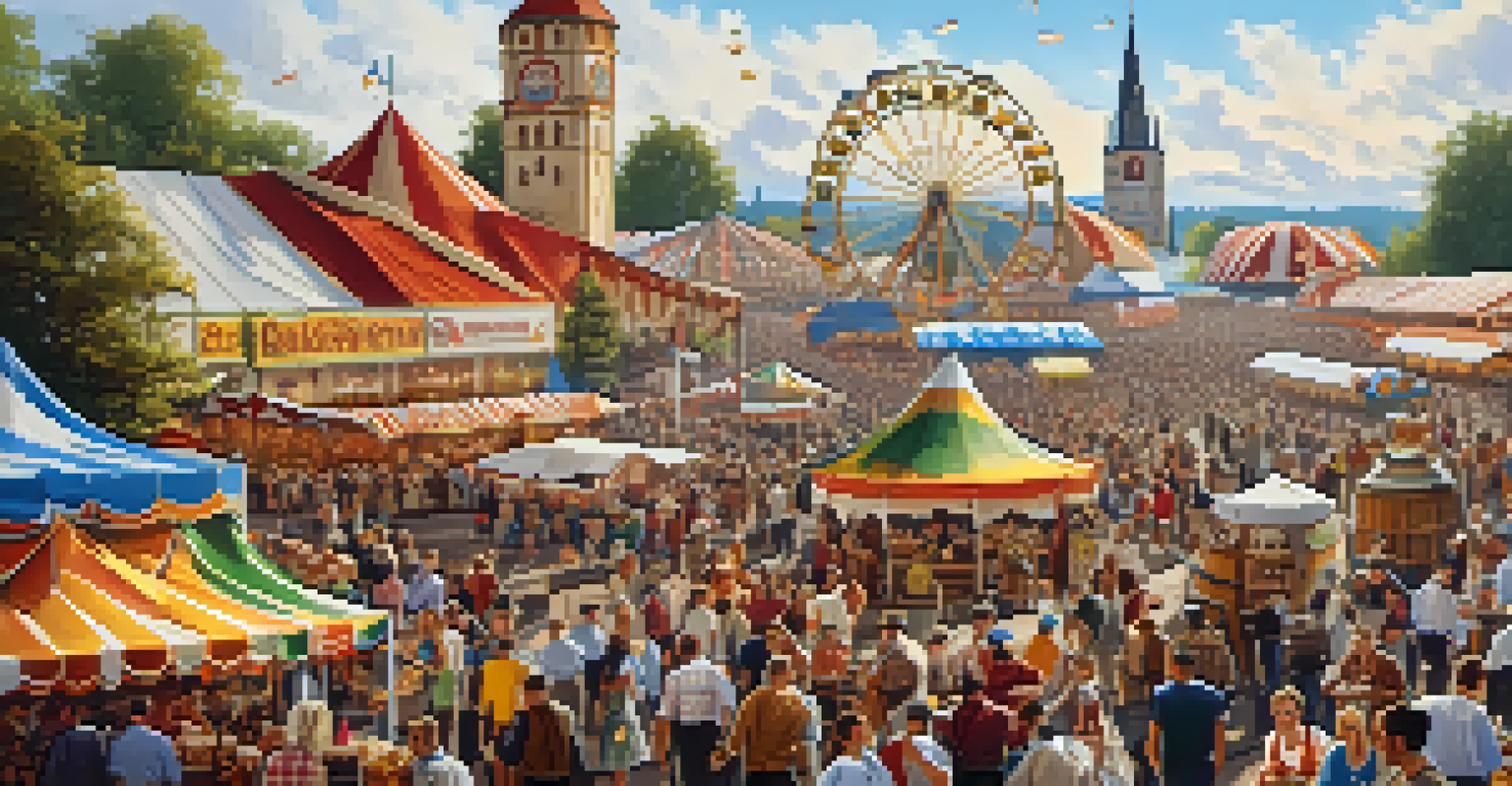Festivals Around the World: A Dive Into Cultural Celebrations

Diwali: The Festival of Lights in India
Diwali, known as the Festival of Lights, is celebrated by millions across India and beyond. This vibrant festival signifies the victory of light over darkness and good over evil. Families decorate their homes with oil lamps, known as diyas, and colorful rangoli designs, creating a warm, inviting atmosphere.
Festivals are the heartbeat of a culture, bringing people together and celebrating life’s joys.
The celebration lasts for five days, each day holding its own significance and rituals. On the third day, people perform Lakshmi Puja, worshiping the goddess of wealth and prosperity. It's a time for families to come together, share sweets, and exchange gifts, creating a sense of unity and joy.
Beyond the religious aspect, Diwali represents a time for personal reflection and renewal. Communities organize fireworks displays, and streets come alive with music and dance, showcasing the rich cultural heritage of India. It's a festival that brings people together, transcending barriers of caste and creed.
Carnival: A Spirited Celebration in Brazil
Carnival in Brazil is a spectacular explosion of color, music, and joy. Held before Lent, this festival is famous for its samba parades, street parties, and vibrant costumes. Cities like Rio de Janeiro transform into a playground for revelers, attracting millions from around the globe.

The highlight of Carnival is the samba parade, where samba schools compete with elaborate floats and dazzling performances. Each school tells a story through their choreography, and the passion of the dancers is infectious. It's a sight to behold, with thousands of spectators cheering and dancing along.
Global Festivals Celebrate Unity
Festivals like Diwali, Carnival, and Oktoberfest bring diverse communities together, fostering a sense of belonging and joy.
But Carnival is more than just a party; it’s a cultural expression of Brazilian identity. It reflects the country’s rich history, blending African, Portuguese, and indigenous influences. This festival fosters a sense of community, reminding everyone to embrace joy and celebrate life together.
Oktoberfest: A Beer Lover's Paradise in Germany
Oktoberfest, held annually in Munich, is the world's largest beer festival, attracting millions of visitors. This 16- to 18-day festival celebrates Bavarian culture with traditional music, food, and, of course, plenty of beer. The air is filled with the sounds of laughter, clinking glasses, and lively folk music that invites everyone to join in the fun.
Tradition is not the worship of ashes, but the preservation of fire.
Visitors can indulge in a variety of traditional German dishes, from pretzels to sausages, while enjoying a stein of freshly brewed beer. The festival is a family-friendly event, with amusement rides, games, and activities for all ages. It’s a great way to experience the warmth of Bavarian hospitality.
Oktoberfest also represents the unity of people from different backgrounds, all coming together to celebrate. It’s a time for friendships to blossom over shared experiences and laughter, creating memories that last a lifetime. This festival embodies the spirit of community, making it a must-visit for anyone seeking a genuine taste of German culture.
Holi: The Festival of Colors in India
Holi, often referred to as the Festival of Colors, is one of the most joyous celebrations in India. Marking the arrival of spring, this festival signifies love, forgiveness, and the triumph of good over evil. People gather to throw colored powders, dance, and celebrate with friends and family, creating a vibrant tapestry of colors.
As the festivities begin, streets come alive with laughter and music. The air is filled with the sweet scent of traditional sweets and the sound of drums. It’s a time for people to let go of past grievances, embrace each other, and spread joy, symbolizing the spirit of togetherness.
Cultural Heritage Through Celebration
Events such as Chinese New Year and the Day of the Dead highlight the importance of honoring traditions and remembering loved ones.
Holi also has deep cultural roots, often associated with various legends. One popular tale involves the devotion of Prahlad and the victory over the demoness Holika. This rich history adds depth to the celebration, making it not just a fun event but a meaningful one that connects generations.
Chinese New Year: A Time for Renewal and Reunion
Chinese New Year, also known as the Spring Festival, is the most important celebration in Chinese culture. It marks the beginning of the lunar calendar and is a time for families to come together, honor ancestors, and wish for good fortune in the coming year. Festivities last for 15 days, filled with traditions and customs.
During this time, homes are cleaned and adorned with red decorations, symbolizing luck and happiness. Families gather for a reunion dinner on New Year's Eve, sharing traditional dishes that carry auspicious meanings. The celebration is marked by dragon and lion dances, fireworks, and the giving of red envelopes filled with money, known as hongbao.
Chinese New Year is a vibrant expression of cultural heritage, emphasizing the importance of family and community. Each year is associated with a specific animal from the Chinese zodiac, adding a unique flavor to the celebrations. It’s a time for reflection, renewal, and hope, resonating with people around the world.
La Tomatina: The World’s Biggest Food Fight in Spain
La Tomatina is a unique festival held annually in Buñol, Spain, where participants engage in a massive tomato fight. This quirky event takes place on the last Wednesday of August and draws thousands of locals and tourists alike, all ready to throw squishy tomatoes at each other. It’s a fun, messy celebration that embodies the spirit of camaraderie.
The origins of La Tomatina are a bit murky, but it’s believed to have started in 1945 during a local festival. What began as a playful food fight has grown into a worldwide phenomenon, attracting tomato-throwers from all corners of the globe. The day is filled with laughter, as people let loose and enjoy the absurdity of the event.
Joyful Expressions of Community Spirit
Festivals like La Tomatina and Mardi Gras showcase the fun and camaraderie that comes from shared experiences and collective celebration.
While it may seem chaotic, La Tomatina promotes community spirit and friendship. It’s a celebration of joy and unity, where participants momentarily forget their worries and revel in the silliness of tossing tomatoes. Ultimately, it’s a reminder that sometimes it’s okay to get a little messy in the name of fun.
Day of the Dead: Honoring Ancestors in Mexico
The Day of the Dead, or Día de los Muertos, is a vibrant Mexican celebration honoring deceased loved ones. This two-day festival, held on November 1st and 2nd, blends indigenous traditions with Catholic influences, creating a unique cultural observance. Families create altars, known as ofrendas, adorned with photos, candles, and favorite foods of the departed.
During this time, it’s common to see colorful skulls and marigolds, symbolizing the cycle of life and death. The atmosphere is filled with music, laughter, and, of course, delicious food. It’s a joyful occasion that reminds participants to cherish the memories of those who have passed while celebrating life.

The Day of the Dead is a testament to the importance of family and remembrance in Mexican culture. It fosters a sense of connection across generations, teaching younger members about their heritage. This festival highlights the beauty of life and death, creating a space for both sadness and celebration.
Mardi Gras: The Festive Carnival of New Orleans
Mardi Gras, or Fat Tuesday, is a lively celebration in New Orleans, famous for its parades, colorful beads, and vibrant nightlife. The festival marks the last day of feasting before Lent, and it’s a time for indulgence and revelry. Streets come alive with music, dance, and delicious food, creating an electric atmosphere that draws people in.
One of the highlights of Mardi Gras is the elaborate parades that showcase stunning floats and masked riders. Each float tells a story and is a product of months of planning and creativity. The excitement is palpable as crowds gather to catch beads and other trinkets tossed from the floats, adding a playful spirit to the festivities.
Beyond the parties and parades, Mardi Gras has deep cultural roots, reflecting the city’s rich history and diverse communities. It’s a celebration that encourages people to come together, regardless of their background, to enjoy the vibrant culture of New Orleans. Mardi Gras is a reminder of the joy found in community and the beauty of shared experiences.